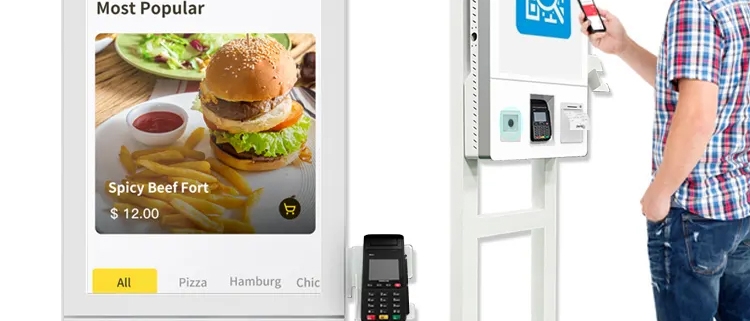Ordering machine self-service kiosk for restaurant
Ordering machine self-service kiosk is a self-service device that allows customers to place their own orders without the assistance of a cashier or staff member. It usually includes a touchscreen interface that allows customers to select their desired items, customize their orders, and pay for them using cash, debit or credit cards. The kiosk then prints out a receipt with the order details and the customer can pick up their order at a designated pick-up area.
Ordering machine self-service kiosks are becoming increasingly popular in the fast food industry as they can significantly reduce labor costs and improve customer satisfaction by providing them with more control over their order. They are also convenient for customers as they can place their orders at any time of day, even when the restaurant is closed.
Ordering machine self-service kiosk typically includes the following hardware components:
- Touchscreen display: The main interface for customers to interact with the kiosk. It allows them to browse menu options, select desired products, and perform payment and other operations
- Payment acceptance device: This can be a cashier drawer, card reader, or mobile payment scanner to accept payments from customers.
- Thermal Printer: Used to print out receipts with order details for customers to pick up their orders.
- Bill acceptor/denominated currency validator: A device that accepts and validates cash payments from customers.
- Rearranging device: A device that rearranges the products selected by customers, such as a conveyor belt or sorting mechanism.
- Control unit: A computer or microcontroller that controls the operation of the kiosk, processes customer orders, and communicates with other devices.
- Cameras and sensors: Used for security and monitoring the kiosk’s operation, as well as to identify any potential problems or malfunctions.
- Audio system: Used to provide audio output, such as instructions or messages to customers.
- Power supply: A power source that provides electricity to the kiosk’s hardware components.
- Network connection: A connection to a network, such as Wi-Fi or Ethernet, to allow the kiosk to communicate with a back-end system or servers.
These are the main hardware components of an ordering machine self-service kiosk, but there can be additional components depending on the specific design and functionality of the kiosk.




